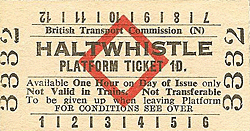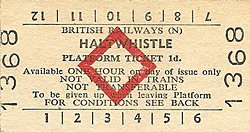
Station Name: HALTWHISTLE
|
| Date opened: | 18.6.1838 |
| Location: | Station Road, off B6322 |
| Company on opening: | Newcastle & Carlisle Railway |
| Date closed to passengers: | Still open |
| Date closed completely: | Still open |
| Company on closing: | Still open |
| Present state: | Platforms and buildings are all in good order. The former booking office and waiting room are a tourist information office. |
| County: | Northumberland |
| OS Grid Ref: | NY704638 |
| Date of visit: | September 1962, April 1972, August 2000 & 4th May 2010 |
Notes: Opened to passengers between 1835 and 1839, the Newcastle & Carlisle Railway was the first to cross England between the navigable waters of the east and west coasts. Biddle (2003) remarks that ‘its notable engineering works, remarkably intact station buildings, and much mechanical signalling make it the least altered line of its length in the country … it is the nearest we have to a working Victorian main line’. Bill Fawcett (2001) suggests that the original stations were the work of John Blackmore, the line’s resident engineer. The Tudor/Gothic style which was used for many of them included mullioned windows surmounted by a hood-mould, raised gables and tall chimney-stacks. Sandstone was favoured in their construction. Although it has been unstaffed for over forty years, Haltwhistle is still a most impressive station, retaining many original Newcastle & Carlisle and North Eastern Railway features. The station house, footbridge, signal box, water tank and water crane are Grade II listed, as is the nearby viaduct over the River South Tyne (the ‘Alston Arches’) on the Alston branch. (The construction of the Newcastle & Carlisle Railway and Haltwhistle station involved the diversion of the South Tyne and the adjacent turnpike road.)
Well into the British Rail era Haltwhistle was essentially a Victorian station. Gas lamps were used until 1972, some on the up platform retaining their casement fittings, although most of them had been replaced with the ‘Sugg’ type, probably in the 1950s. As with all of the intermediate stations between Hexham and Carlisle, totem signs were never installed. The running-in boards were of plain wood, painted in BR(NE) colours, those on the island platform reading ‘Haltwhistle change for Alston’ with 'Haltwhistle change for Newcastle & Carlisle’ on the reverse. Something of Haltwhistle’s appeal was lost when the Alston branch closed in 1976, but the station is well worth a visit. The signal box was decommissioned in 1993 when colour light signalling was introduced. A new prefabricated building on the up side replaced it. Alston, 1000 ft above sea level, claims to be England’s highest market town. Since at least the fifteenth century, lead had been mined, and by 1768, 119 mines operated in Alston parish. Isolation from markets was a handicap. Although it was not the first proposal for a branch to Alston, the Newcastle & Carlisle Railway’s Haltwhistle-Alston-Nenthead branch received the Royal Assent on 26 August 1846. National economic problems delayed construction. When building began, the five-mile section beyond Alston was not proceeded with. The junction at Haltwhistle was adjusted to face Carlisle (the county town of Cumberland, in which Alston was situated) rather than Newcastle. An addition to the original plans was a branch from Lambley to meet the Brampton Railway at Halton Lea Gate. The revised plans received the Royal Assent on 13 July 1849. The branch required substantial earthworks and structures. There were no watersheds to cross, nor tunnels to bore, but the 13-mile route climbed from 405ft to 905ft above sea level and involved three crossings of the South Tyne and viaducts over tributaries. Most structures were designed for double track and sturdily built of sandstone. Lambley (Grade II*) is particularly striking, but others at Burnstones, Knar Burn and Gilderdale Burn, and the ‘Alston Arches over the Tyne at Haltwhistle (each Grade II) are also worthy of note. The gradient was almost continually uphill from Haltwhistle, including 1 in 70 for 1½ miles between Plenmeller and Featherstone Park; and 1 in 56, the steepest stretch, for a mile near Barhaugh, between Slaggyford and Alston. A mile-long cutting was needed between Haltwhistle and Featherstone Park.
Unfortunately no sooner had the branch been completed that lead mining began a rapid and continuous decline. Depopulation accompanied this recession; the population in Alston, Garrigill, and Nenthead peaked at 6,815 in 1851 and fell almost continuously to only 1,909 in 1971. Some cheer was brought by limited development of coal and zinc mining. In the late 1850s two weekday return passenger trains called at all stations. By 1863 there were three. Trains took a leisurely 40 minutes in each direction. The 1910 service increased to four, with an extra Saturday evening return trip, and a five-minute faster journey. Whilst Alston’s ‘twin’ branch to Allendale closed to passengers in 1930, Alston still had its 1910 frequency. In summer 1946 Alston enjoyed eight weekday return trains, the first departure at 5.41 am, but by summer 1954 there were seven on Saturdays and only five on weekdays.
Since the early days, the first advertised service of the day left Alston, where the branch locomotive was stabled. This practice continued until November 1959 when a 6:30 am departure from Haltwhistle was introduced, running non-stop (another novelty!) to Alston in thirty minutes, to form the 7:05 am departure (all stops) to Haltwhistle. British Rail censuses in 1970 found no passengers using the first Haltwhistle-Alston train of the day. By its final timetable there were six weekday and seven Saturday returns, taking 34 minutes from Haltwhistle to Alston, and 32 back to Haltwhistle.
Jenkins (The Alston Branch, 1991) assumes that motive power was provided in the mid-19th Century by former main line engines. Towards the end of that century Fletcher BTP 0-4-4Ts (classified as G6 by the LNER) were used, though in the NER period Worsdell Class A 2-4-2 Passenger Tanks were also employed. At first one engine was based at Alston. By 1900 there were two, one for passenger and the other for goods trains. Two elliptical-roof bogie coaches carried passengers in the early 20th Century, with a spare stabled at Alston. In the LNER period G5 0-4-4 and A8 4-6-2 tanks operated the passenger trains. Goods were hauled by J21 and J39 tender engines. The 1950s saw a variety of steam locomotives on the branch including ex-LMS 4MT 2-6-0 and 3MT 2-6-0’s. Passenger services were progressively taken over by dmus (generally Metro-Cammell Class 101) from autumn 1959, which operated until closure. However, German 56-seat railbuses were trialled on the branch in 1965. They gave a rough ride and were mechanically unreliable. Consequently they were not adopted, although they worked some East Anglian branches. Towards closure - and beyond
In its last months Alston was, belatedly, publicised by British Rail, who extolled the charms of the line, and offered trips by scheduled services from London. A ‘circular’ bargain-fare was available from King’s Cross and Euston, via Carlisle or Newcastle, to Alston. On the last day of service, Saturday 1 May 1976, some 5,000 passengers travelled on scheduled services on the branch, with yet more on special trains. The final train left Alston at 21:09 to the accompaniment of a lament played by two pipers, and the thunder of detonators. On 3 May 1976 rail services officially ended.
In January 1977 South Tynedale communities were isolated; roads were blocked by snow. This time the railway could not come to the rescue. The STRPS was committed to keeping the line in operation, but could not afford the purchase price of £160,000 asked by British Rail. BR would not permit the society operate trains on the branch to help raise money to buy the line. Track dismantling began in winter 1976-77. In March 1977 STRPS had the option to buy the last 1½ miles of track, from Gilderdale to Alston, for £40,800. Once again the price proved too high. Demolition continued, and all rails were lifted by June 1977. Happily, this is not the end of the story. Cumbria County Council bought Alston station and the Cumbrian section of trackbed in 1979, enabling the station to be used as a tourist information centre. In 1983 the STRPS opened a 2ft gauge tourist railway at Alston, its trains hauled by Phoenix, a forty year-old 4-wheeled Hibberd 40hp diesel locomotive. The line was extended 1½ miles to Gilderdale Halt in 1986; a Light Railway Order was obtained in October 1987 for this section. A further ¼ mile to Kirkhaugh Halt opened in 1999. The South Tynedale Railway intends to reach Slaggyford, having obtained planning permission for this project in 1986, and ultimately Haltwhistle. Reinstatement of the branch has been aided by the English Tourist Board, the local authorities, and the Manpower Services Commission. Today the South Tyne Way footpath and cycleway follows the course of the Alston branch for much of its length.
Stations Although all of the intermediate stations were de-staffed by 1967, none of them had Halt added to their name, even though the suffix was applied widely by British Rail until 1968-9. Sources:
Further reading: Eastern Main Lines - Hexham to Carlisle including the Alston and Brampton Branches by Roger Darsley. (Pub: Middleton Press 2006) Other web sites: South Tynedale Railway. History, photographs, timetable and all the latest news of this popular line. To see other stations on the Alston branch click on the station name: |
old7.jpg)
Copyright photo from John Alsop


old9.jpg)
Copyright photo by H C Casserley
old6.jpg)
Photo by Brian Johnson
old19.jpg)
36.jpg)
Photo by Alan Young
7.jpg)
Photo by Nick Catford

40.jpg)
17.jpg)
Photo by Rob Hunter
Click here for more pictures of Haltwhistle station
| Last updated: Sunday, 21-May-2017 10:58:27 CEST |
© 1998-2010 Disused Stations
|





.gif)


 Home Page
Home Page